Production Notes - The Man With
The Golden Gun
Harry
Saltzman had been keen to film Ian
Fleming's less than
memorable final Bond novel for some time, telling new boy Roger
Moore that it would be the next in the series almost as soon
as Moore started shooting Live And Let Die. So it came as no
surprise
in 1974 to find Tom Mankiewicz back at his typewriter trying
to piece something together from the novel.
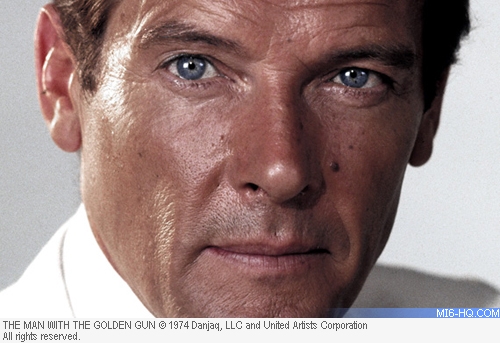
Above: Roger Moore as
James Bond.
|
The only way that Mankiewicz was going to get a workable script
was to abandon much of Fleming's original and concoct his own
tale based around the title. Mankiewicz set to work but hadn't
got all that far before a falling out with Guy Hamilton [directing
his third consecutive Bond film] led to him unexpectedly leaving
the project.
This left the way open
for the return of Richard Maibaum who had left the series
after Mankiewicz had been brought
in to rework his script for Diamonds Are Forever [1971].
Maibaum
was not the most immediate candidate to fill Mankiewicz's
shoes - his relationship with Harry Saltzman had never
been that great and he made no secret of his dislike
of Moore's version of Bond. But, for whatever reason, he
relented
and turned in his first draft on 7 January 1974. Having dealt with changes to their leading man on each
of the last three films, it must have come as some relief
to Saltzman and Broccoli to have no such concerns this
time out. Roger Moore was back in the saddle and was to
be supported by Christopher
Lee as Scaramanga.
Lee was
Fleming's step-cousin and frequently played golf with
the author. His willingness to take on the role of Scaramanga
stemmed not only from his family ties but also from his
desire to shake off the Hammer horror typecasting that
had been plaguing his career throughout the 60s and early
70s. But Lee wasn't the producers' first choice for the
role - that had been veteran American actor Jack Palance. |
|
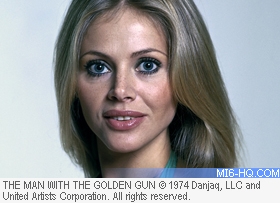
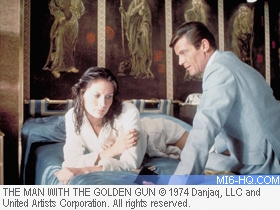
Above: Britt Ekland as Mary Goodnight (top) and Maud
Adams as Andrea Anders.
|
Other members of the cast included Britt
Ekland, who had originally
auditioned for the role of Scaramanga's mistress. Hamilton had
been so impressed by photographs taken of her in a bikini that
he offered her the larger role of Mary Goodnight instead. Making
his second, and last, appearance in the series was Clifton
James,
returning to the fold as redneck Louisiana sheriff J W Pepper
who locked horns with Bond in Live and Let Die [1973]. Here, Pepper
is astounded to be reunited with Bond while on holiday in Thailand,
temporarily roped in to help in the pursuit of Scaramanga.
The crew assembled on 6 November 1974 in Hong Kong to shoot the
scene where Bond explores the partly submerged remains of the
Queen Elizabeth and finds M waiting for him. Moore himself was
doubled for most of the scene [interiors were filmed later at
Pinewood] as the actor wasn't due to start work until the following
spring.
|
The Man With the
Golden Gun had its world premiere at
the Odeon Leicester Square on 18 December 1974 and, like
previous films in the series, it started off well at the
box office but the
returns were to tail off dramatically after the first few
days.
The film opened in the States the night
after its British premiere and this time managed to draw
in only
11.1 million admissions, a new all-time low for the series.
The film was to make back $97.6 million on its budget
of just $7 million, so it was hardly a disaster. But something
seemed to be very wrong in the Bond camp and audiences
were starting to vote with their feet. And they weren't the only ones. The long simmering dispute
between Saltzman and Broccoli finally boiled over during
the making of The Man With the Golden Gun. Broccoli had
done most of the work on the film while Saltzman was left
telling the press that he had no desire to stay with the
series much longer.
On 11 November 1974, a month before the
film's premiere, the London Evening Standard had reported
that Saltzman was
preparing to sell his half share in Danjaq, EON's parent
company, to Columbia Pictures. |
|
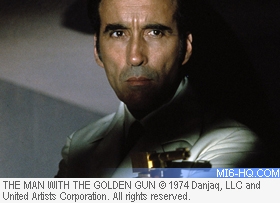
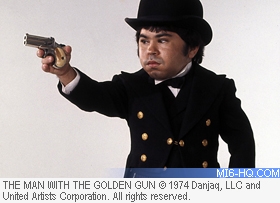
Above: Christopher Lee as Scaramanga
(top) and
Herve Villechaize as Nick Nack.
|
This clearly was going to cause
Broccoli major headaches - although it was EON that held the
rights to the Bond character,
the films' finances were coming from United Artists. For a half
share in the character to be held by a rival company would have
been an embarrassment for Broccoli, who had hoped that he was
going to be able to buy out Saltzman's half-share for himself.
|
It soon became clear that Saltzman was
in some financial difficulties, perhaps influencing his
decision to bail
out of the series at this point. Apart from the Bond films,
Saltzman had been producing other films, including The
Battle of Britain [1969] and Val Guest's entirely dreadful
Tomorrow [1972], both of which had been loss-makers at
the box office.
In April 1978, The Times reported that
Saltzman had been taken to court by a firm of American
lawyers for non-payment of debts. He revealed that Broccoli
had agreed to wind up Danjaq in 1972 but had reneged
on the agreement and subsequent legal action by Saltzman
had
come to nothing.
The dispute between Broccoli and Saltzman rumbled on for
a year until, on 23 December 1975, United Artists chairman
Arthur Krim announced that UA had bought out Saltzman's
shares in the series. Saltzman went on to a number of entertainment
industry business deals, including a failed attempt to
buy Shepperton Studios and a more successful attempt to
buy a controlling share in the theatrical company HM Tennant.
|
|
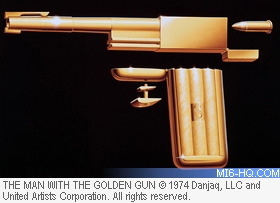
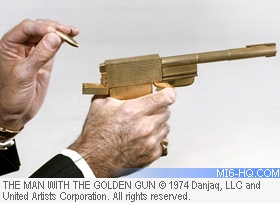
|
While Broccoli continued alone on the Bond series, gradually
bringing in members of his family to assist him, Saltzman only
produced two more films, Nijinsky [1980] and Dom Za Vesanje [1989]
before his death in Paris in September 1994.